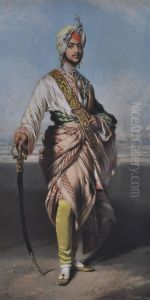Richard James Lane Paintings
Richard James Lane was a prominent British lithographer and engraver, born in 1800, whose career spanned much of the 19th century, a period marked by significant developments in the world of printmaking and the visual arts. Lane's contributions to the field of lithography were considerable, establishing him as one of the leading figures in this medium in Britain. His works are characterized by their meticulous detail, clarity, and expressive portraits, capturing the likenesses of some of the most notable figures of his time.
Lane's artistic journey began under the tutelage of his uncle, the renowned painter and engraver Samuel William Reynolds, who was a significant influence on Lane's early development as an artist. This mentorship provided Lane with a strong foundation in the principles of drawing and engraving. However, it was his exploration and mastery of lithography, a relatively new printmaking technique at the time, which had been invented in the late 18th century, that distinguished his career. Lithography allowed for a more fluid and expressive line than traditional engraving, which Lane exploited to great effect in his portraits.
Throughout his career, Richard James Lane produced a vast array of lithographs, including portraits of Queen Victoria, whom he served as Lithographer-in-Ordinary, and other members of the royal family, as well as literary, scientific, and political figures of the day. His works not only serve as a testament to his skill as an artist but also as a valuable historical record of the era's prominent personalities. Lane's lithographs were highly sought after by both the public and his subjects, thanks to their accuracy and the way they captured the character and spirit of the sitter.
Lane's contributions to the field of lithography extended beyond his artistic output. He was instrumental in advancing the technical aspects of the medium, experimenting with and improving upon the lithographic process. This not only enhanced the quality of his own works but also had a lasting impact on the practice of lithography in Britain.
Richard James Lane passed away in 1872, leaving behind a legacy that has endured in the world of printmaking. His works are preserved in numerous collections and museums, offering insight into the artistic and cultural milieu of 19th-century Britain. Lane's dedication to his craft and his innovative spirit in the realm of lithography have cemented his place as a key figure in the history of British art.
